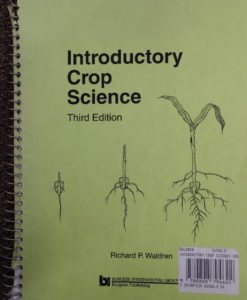I didn’t begin my University education in the University of Nebraska-Lincoln’s College of Agricultural Sciences and Natural Resources. I was pre-med. I loved biology. But as I looked down the long road of required coursework in order to earn my M.D. and realized how much blood I might have to be dealing with (I really don’t enjoy blood), I hesitated. My dad, who graduated from UNL with his B.S. in Agronomy in 1972, suggested that I take an agronomy course. Agronomy is also called crop science, which is like applied botany, and botany is like applied biology, so I said “sure”. Dr. Rick Waldren was my first Agronomy professor (I still have the bright green covered, wire-bound textbook!). He liked his job, and it showed. He made learning about epicotyls and glumes kind of fun!
When I decided to change my college major to Agronomy, I soon found a job working as an undergraduate research assistant for the soil fertility project at UNL. On my first day, Dr. Dan Walters, my new boss, asked me an important question. He said in order to work for him, I needed to know the answer. His question:
“What is the difference between soil and dirt?”
This wasn’t exactly easily answered. First, there is a whole branch of science dedicated towards studying the first, and I was just starting in on the classes! Soil isn’t just the strange stuff that we walk over and build houses on and plant gardens in. Soil is a whole world unto itself, a living, breathing entity; an ecosystem with minerals, air, water, and more living creatures than you or I could count. Plants don’t just use soil to grow their roots into in order to anchor themselves from blowing or washing away. Roots “drink” the water, “breathe” the air, and uptake nutrients that the plants need to grow and live. Think of them as hairy, fingerlike straws. Living on these roots and in the tiny air holes and water bubbles are living creatures—bacteria and fungi and other tiny organisms that co-exist with the “bottom half” of those green things that stick out of the ground. Intricate chemical and biological processes take place. So complicated, in fact, that scientists have given “soil” a science of its own. Soil is its own little world.
To the average person, there is no difference between soil and dirt. The words are used interchangeably. So when Dr. Dan asked me the difference, I was stumped. Was this a trick question? WAS there a difference?
He smiled, and, after requesting that I purchase a pair of steel toe Red Wings from the store in Havelock for our field work, he explained.
Soil is indeed a complicated substance, something I spent the next seven years learning about….and just “scratched the surface”, so to say.
But dirt? Dirt is that junk under your fingernails and between your toes. Dirt is what is stuck on your shoes and gets tracked in on the floors and scatters on your furniture. Dirt is the reason you jump in the shower and pull out the cleaning supplies. In other words, dirt is determined by “location, location, location”. The answer was simple after all. Dirt is soil where you don’t want it.

My first Agronomy textbook, from “Agronomy 101” at UNL in 1995.
